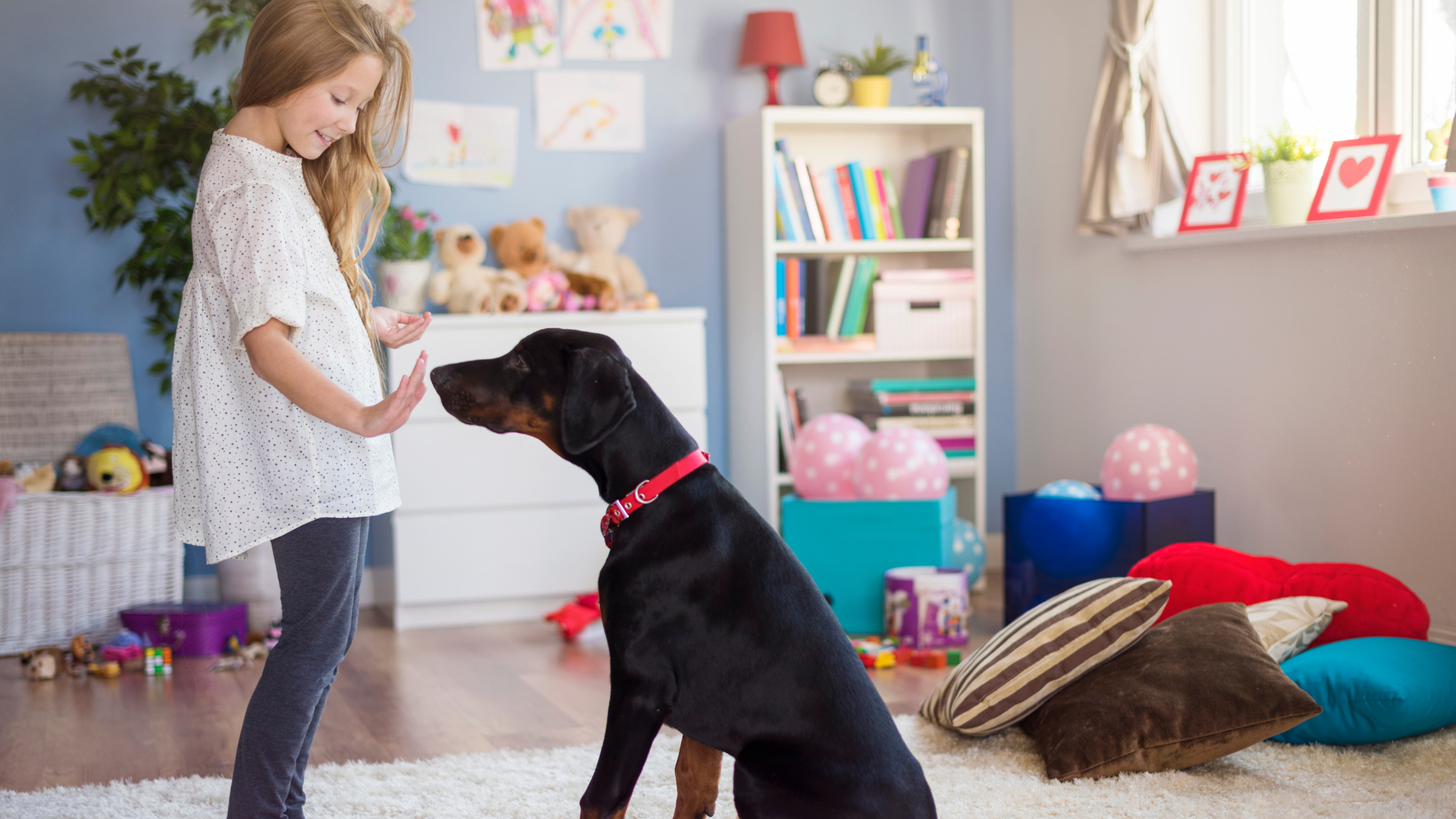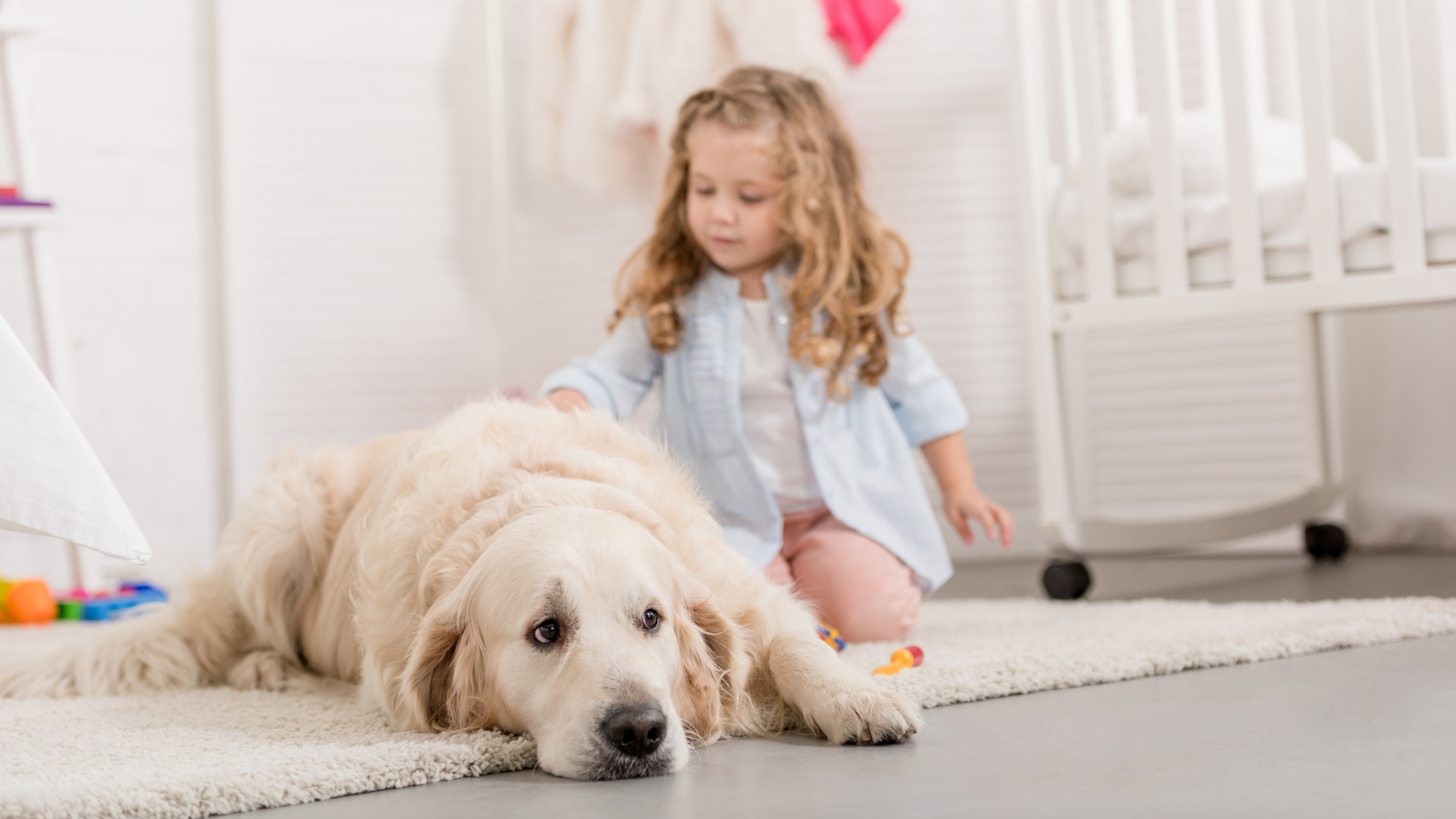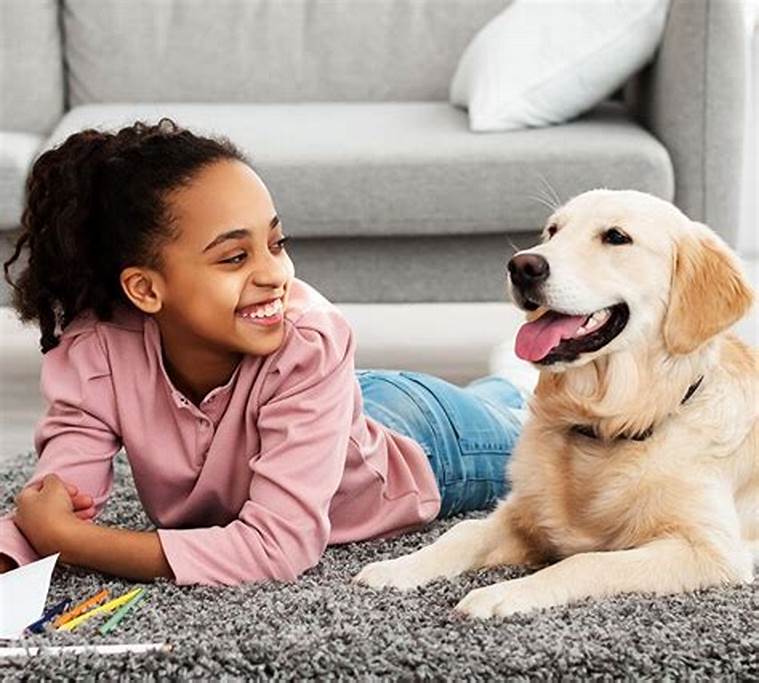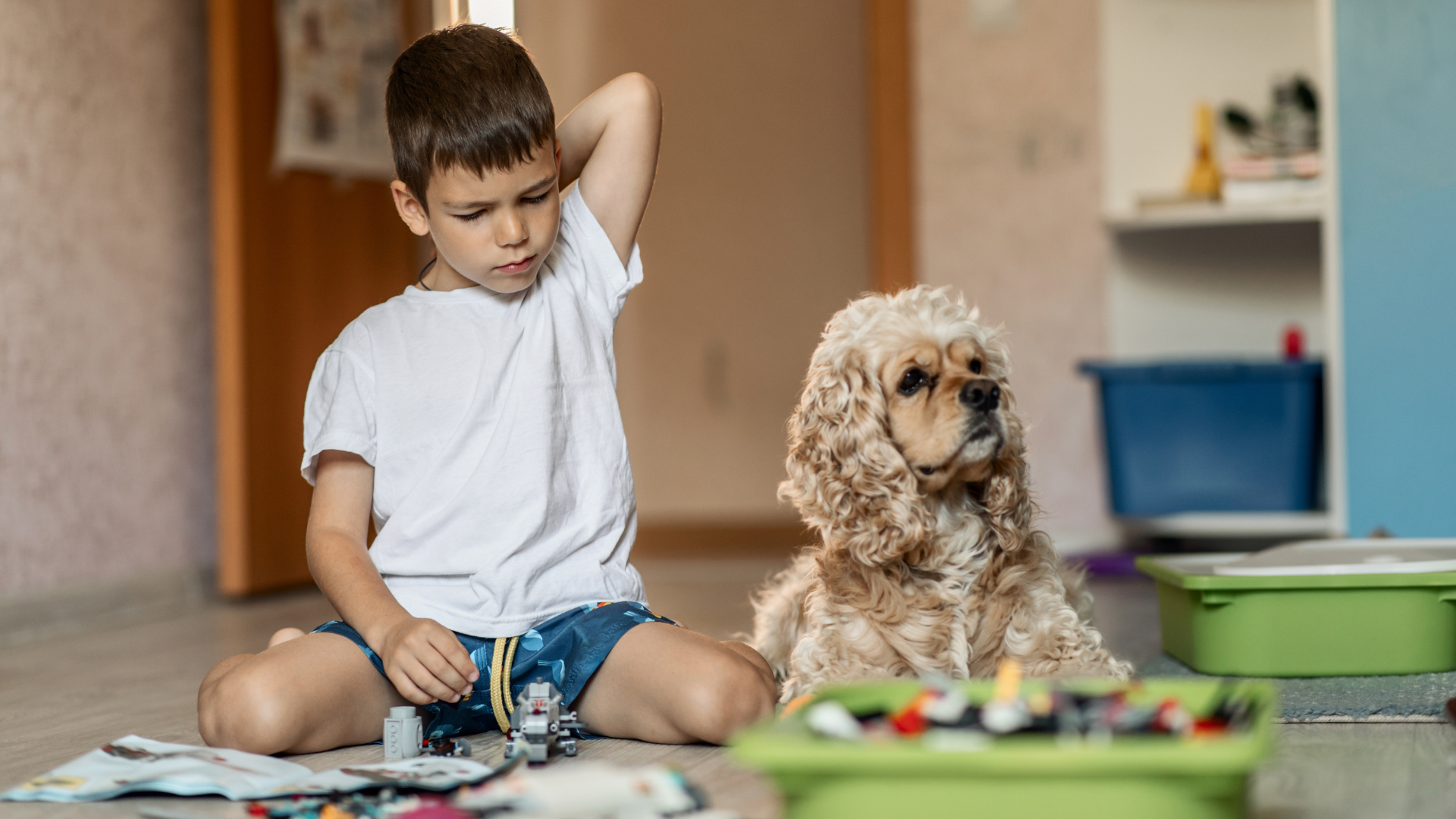Dogs and young children can be a great combination, but it's important to create a safe interaction space for both parties. Dogs can be unpredictable, and children may not know how to behave around them. Without proper supervision and guidance, accidents can happen.

Creating a safe interaction space involves several factors. First and foremost, it's important to choose the right dog breed for your family. Some breeds are more patient and tolerant of children than others. Additionally, dogs should be trained and socialized to interact with children. This includes teaching them basic commands and exposing them to different situations.
Another important factor is teaching children how to behave around dogs. Children should be taught to approach dogs calmly and avoid sudden movements or loud noises that may startle them. They should also be taught to respect a dog's space and not to bother them when they're eating or sleeping. By creating a safe interaction space and teaching both dogs and children how to behave around each other, families can enjoy a happy and healthy relationship between their furry and human members.

Understanding Canine Behavior
Dogs are social animals and they have their own ways of communicating with humans and other dogs. Understanding canine behavior is crucial in creating a safe interaction space for dogs and young children.
Dog Body Language
Dogs use their body language to communicate their feelings and intentions. It is important to pay attention to their body language to avoid misinterpreting their behavior. Some common body language cues include:
- Tail position: A wagging tail does not always mean a happy dog. A high and stiff tail indicates alertness or aggression, while a low tail indicates fear or submission.
- Ear position: Forward-facing ears indicate attentiveness, while flattened ears indicate fear or submission.
- Eye contact: Direct eye contact can be perceived as a threat by some dogs, while avoiding eye contact can indicate fear or submission.
- Body posture: A tense and stiff body indicates aggression or fear, while a relaxed body indicates a calm and friendly dog.
Common Triggers for Dogs
Dogs can be triggered by various factors, such as loud noises, sudden movements, or unfamiliar people or animals. It is important to identify and avoid these triggers to prevent aggressive behavior. Some common triggers for dogs include:
- Loud noises: Thunderstorms, fireworks, and loud music can startle and stress dogs.
- Sudden movements: Dogs can perceive sudden movements as a threat or an attack.
- Unfamiliar people or animals: Dogs can become territorial and defensive when encountering unfamiliar people or animals.
Signs of Stress in Dogs
Stress can cause a variety of behavioral changes in dogs, including aggression and fear. It is important to recognize the signs of stress in dogs to prevent negative interactions. Some signs of stress in dogs include:
- Panting or drooling
- Pacing or restlessness
- Excessive barking or growling
- Avoiding eye contact or hiding
- Shaking or trembling
By understanding canine behavior, identifying common triggers, and recognizing signs of stress, you can create a safe interaction space for dogs and young children.
Child Development and Dog Interactions

Age-Appropriate Behavior
Children's behavior and interactions with dogs should be age-appropriate. Young children are often unpredictable, and they may not understand how their actions affect dogs. Toddlers, for example, may pull on a dog's tail or ears, which can lead to aggressive behavior in dogs.
As children grow and develop, they can learn how to interact with dogs in a safe and appropriate manner. It is important to teach children to respect dogs and their boundaries.
Teaching Children Boundaries
Teaching children boundaries when it comes to interacting with dogs is crucial for their safety and the safety of the dog. Children should be taught to ask for permission before approaching a dog and to avoid touching a dog that is sleeping or eating.
Parents should also teach their children to avoid hugging or kissing dogs, as this can be seen as a threat by the dog. Instead, children should be encouraged to pet dogs gently and to avoid making sudden movements that may startle the dog.
Recognizing Safe Play
Children should be taught to recognize safe play between dogs and to avoid interfering with it. Safe play includes dogs wagging their tails, play-bowing, and taking turns chasing each other.
However, children should be taught to recognize signs of aggression in dogs, such as growling, showing teeth, or stiffening their body. If a child sees these signs, they should be taught to back away slowly and to avoid interacting with the dog.
In conclusion, teaching children how to interact with dogs in a safe and appropriate manner is essential for preventing dog bites and ensuring the safety of both children and dogs. By understanding child development and dog interactions, parents can create a safe interaction space for their children and their dogs.
Creating a Safe Environment
When it comes to creating a safe interaction space for dogs and young children, it's crucial to establish a secure environment. Here are some tips to help you create a safe environment for your furry friend and your little ones.

Designating Dog Zones
One of the best ways to ensure safety is to designate specific areas for your dog to play and rest. By creating a designated dog zone, you're providing a safe space for your furry friend to retreat to when they need a break. This area should be equipped with water, food, and toys to keep them entertained.
Child-Free Spaces
It's important to establish child-free spaces in your home to give your dog a break from children. This is especially important if your dog is showing signs of stress or anxiety around children. These spaces should be clearly marked and off-limits to children.
Safe Toys and Equipment
When it comes to toys and equipment, it's important to choose items that are safe for both dogs and children. Avoid toys that are small enough to be swallowed or that have sharp edges. Opt for toys that are durable and can withstand rough play.
In addition to toys, it's important to have equipment that's safe for both dogs and children. This includes leashes, collars, and harnesses. Make sure that the equipment fits properly and is in good condition.
Creating a safe interaction space for dogs and young children requires careful planning and consideration. By designating dog zones, establishing child-free spaces, and using safe toys and equipment, you can create a safe and enjoyable environment for everyone involved.
Supervision and Intervention

Active Supervision Techniques
Active supervision is key to ensuring the safety of both dogs and young children during their interactions. Parents and caregivers should always be present and engaged during playtime between children and dogs. This means avoiding distractions such as phones, computers, or other electronic devices and staying within arm's reach of the child and dog at all times.
It is also important to actively monitor the child's behavior and the dog's body language. Parents and caregivers should be aware of signs of stress in the dog such as growling, barking, or showing teeth. Similarly, they should watch for signs of fear or discomfort in the child such as crying or hiding.
Intervening in Risky Situations
Even with active supervision, risky situations can arise during interactions between dogs and young children. In these situations, it is important to intervene quickly and calmly to prevent any harm from occurring.
One effective intervention technique is to redirect the child's attention away from the dog. This can be done by offering the child a toy or other distraction or by simply moving the child to a different area.
If the dog is exhibiting signs of stress or aggression, it may be necessary to physically separate the dog from the child. This can be done by using a leash or other physical barrier to create a safe distance between the two.
Fostering Positive Interactions
In addition to active supervision and intervention, parents and caregivers can take steps to foster positive interactions between dogs and young children. This can include teaching children how to properly pet and interact with dogs, as well as providing the dog with plenty of exercise and mental stimulation to reduce stress and anxiety.
It is also important to set clear boundaries and rules for both the child and the dog. For example, children should be taught not to approach the dog while it is eating or sleeping, and the dog should be trained not to jump on or play too rough with the child.
By using these techniques, parents and caregivers can create a safe and positive interaction space for dogs and young children.
Training and Socialization
Dog Training Basics
Training is an essential part of creating a safe interaction space for dogs and young children. Dogs need to learn basic commands, such as "sit," "stay," and "come," to ensure they can be controlled and kept safe around children. Positive reinforcement training is the most effective method to teach dogs these commands.
Positive reinforcement training involves rewarding dogs for good behavior rather than punishing them for bad behavior. Rewards can include treats, toys, and praise. This method helps dogs associate good behavior with positive outcomes and encourages them to repeat that behavior in the future.
Socializing Dogs with Children
Socialization is also crucial for dogs to interact safely with children. Socialization involves exposing dogs to different people, animals, and environments to help them become comfortable and confident in various situations.
Socializing dogs with children should be done gradually and under close supervision. Dogs should be introduced to children in a controlled environment, such as a fenced-in yard, and gradually exposed to different children of different ages and sizes.
It's important to watch for signs of stress or discomfort in the dog, such as growling or backing away, and to intervene if necessary. Socializing should be a positive experience for both the dog and the child.

Obedience Commands for Safety
Teaching dogs obedience commands can also help keep children safe. Commands such as "leave it" and "drop it" can prevent dogs from picking up and potentially swallowing harmful objects.
Commands such as "off" and "down" can also keep dogs from jumping on or knocking over children. It's essential to teach these commands using positive reinforcement training, as punishment-based methods can cause aggression and fear in dogs.
Overall, training and socialization are critical components of creating a safe interaction space for dogs and young children. By teaching dogs basic commands and socializing them with children, parents can help prevent accidents and promote a positive relationship between dogs and children.
Emergency Preparedness
First Aid for Dog Bites
It is important to know how to properly care for a dog bite in case of an emergency. The first step is to wash the wound with soap and water and apply pressure to stop any bleeding. It is important to seek medical attention if the wound is deep or if there are signs of infection such as redness, swelling, or pus. In addition, it is important to know the vaccination status of the dog and to seek medical attention if the dog is not up-to-date on its vaccinations.
Educating on Emergency Response
Parents and caregivers should educate themselves and their children on how to respond in case of a dog bite or attack. This includes teaching children to stay calm, to avoid eye contact with the dog, and to slowly back away from the dog. It is also important to teach children to never approach a dog that is eating, sleeping, or caring for puppies.
Preventative Measures
Preventing dog bites is the best way to ensure the safety of both dogs and young children. This can be achieved by teaching children to respect dogs and their personal space, as well as by supervising all interactions between dogs and children. It is also important to properly socialize dogs and to never leave them unsupervised with young children. In addition, parents and caregivers should be aware of any warning signs that a dog may be feeling stressed or uncomfortable, such as growling or baring teeth, and should remove the child from the situation immediately.
Legal and Ethical Considerations
Understanding Liability
When dogs and young children interact, there is always a risk of injury. Therefore, it is important to understand the legal and ethical implications of such interactions. In the event of an injury, liability may fall on the dog owner, the child's caregiver, or both. It is crucial to be aware of the laws and regulations in your area regarding dog ownership and interactions with children.
Responsible Pet Ownership
To prevent any potential injuries, it is essential for pet owners to be responsible. This includes properly training and socializing their dogs, keeping them on a leash or in a fenced area, and supervising them during interactions with children. Additionally, pet owners should ensure that their dogs are up-to-date on vaccinations and do not pose a risk to children.
Community Guidelines
Creating a safe interaction space for dogs and young children also involves following community guidelines. This may include adhering to leash laws, picking up after your dog, and respecting other people's space. It is important to be aware of the rules and regulations in your community and to follow them accordingly.
By understanding the legal and ethical considerations involved in creating a safe interaction space for dogs and young children, pet owners and caregivers can take the necessary precautions to prevent injuries and ensure the safety of everyone involved.
Conclusion
Creating a safe interaction space between dogs and young children requires patience, education, and vigilance. By understanding dog behavior, preparing your dog, and teaching children respectful behavior, you can foster a positive and joyful relationship that benefits both parties.

FAQs
- Can any dog be safe around children?
- Not all dogs are suitable for households with young children. Breeds and individual temperaments should be considered.
- How do I know if my dog is comfortable around children?
- Monitor your dog's body language and reactions. Seek professional advice if unsure.
- What should I do if my child is bitten by a dog?
- Clean the wound and seek medical attention immediately. Assess the situation to prevent future incidents.
- How can I teach my child to be responsible for a pet?
- Start with simple tasks like feeding or grooming under supervision, gradually increasing responsibilities.
- Are there age-specific guidelines for interacting with dogs?
- Yes, tailor teaching to the child's age and maturity level to ensure understanding and safety.




